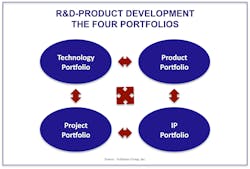Product, Project, Technology, and IP Portfolios
In the 1990s, life was simple. Marketing, or product management, maintained the “product portfolio.” In the largest companies, there was perhaps also a technology portfolio. The “R” part of the R&D organization would work with marketing to plan future products based on the projected availability of technologies still in development.
Today, having both a technology and a product portfolio is considered the rock-bottom minimum regardless of company size. Just about all companies actively maintain these soft assets—only the degree of formality differs. And over the past decade, these portfolios became more closely tied together with the advent and acceptance of roadmapping (which charts the path new technologies and products take as they evolve into commercial readiness). In between each and every portfolio snapshot in time, the roadmap provides guidance on activities needed to reach the portfolio’s next incarnation.
This file type includes high resolution graphics and schematics when applicable.
It would be great if we could just call it a day with two portfolios and the roadmaps that tie them together. But that is no longer best practice. We now also need a project portfolio and an intellectual property (IP) portfolio to be a best-practices company.
Project portfolio. As previously defined in my June column, a project is a temporary organizational vehicle used to develop products. When a project ends, the product(s) it creates live on. The need for project portfolios has been partially driven by the tremendous growth in project managers and project management organizations. These now-large organizations need to prioritize and sequence their inventories.
The real driving force for project portfolios was the advent of the platform-derivative development strategy developed for IBM’s PC in the early 1980s (as mentioned in my March column). By 2008, platform-derivative had become the predominant corporate product-development strategy. Growth in that strategy lead to many companies having gigantic projects that ran many years to develop the platform and the first several of its derivatives.
The root of the need for project portfolios lies in the difficulty of economically justifying the platform by itself. The platform’s value is largely realized through its derivative products that are subsequent to the platform, rather than the initial platform. As such, the initial platform and several derivatives had to be bundled together to earn a high enough ROI for management to give the thumbs-up. The approval package would then be turned into a project containing many insufficiently delineated sub-projects running over many years.
But the vast majority of companies execute gigantic all-in-one projects very poorly. All of a sudden, many companies had several gigantic projects on their books. Never mind the turnover in project staff every couple years causing discontinuity—lean thinking is clear that small batch sizes are both better and faster.
Project portfolios are far more than accounting diagrams for an inventory of projects. Project portfolios are active management tools for configuring projects in size, sequence, staffing levels, elapsed time, and actual time to realize a best mix of projects in support of product and technology portfolios. Alas, for too many companies, these portfolios remain an accounting diagram and are contrarian to lean thinking and smaller batch sizes.
IP portfolio. A discussion of an IP portfolio and its associated best practices would be longer than this column allows. Suffice to say, given how easy it now is to separately monetize IP rather than monetizing it in a product (as mentioned in my July column), and the need to protect IP, an integrated IP strategy is now the best product strategy for most companies.
These days, companies cannot safely conduct focus groups, use contractors, or contact suppliers and distributors until the IP has reached a certain level of preparedness. In many ways, IP portfolios have many of the same attributes of technology portfolios. The lack of readiness directly limits the ability to commercialize products.
Most companies compete today by improving their product and technology portfolios and associated roadmaps. An increasing number of companies are now becoming more IP-savvy. Their challenges are more related to combining IP with product development. Historically, IP was a separate arms-length organization.
This file type includes high resolution graphics and schematics when applicable.
About the Author
Bradford Goldense
Contributing Technical Expert
Bradford L. Goldense is founder and president of Goldense Group, Inc. [GGI] (www.goldensegroupinc.com), a consulting, market research, and education firm focused on business and technology management strategies and practices for product creation, development, and commercialization. He has been an adjunct faculty member of the graduate engineering school at Tufts University's Gordon Institute for 19 years. Goldense is a Certified New Product Development Professional [NPDP], a Certified Manufacturing Engineer [CMfgE], a Certified Computer Professional [CCP], and is Certified In Production & Inventory Management [CPIM]. He holds over 200 registered copyrights and is a recognized subject-matter expert, including appearances on PBS and CNBC. He has consulted to over 250 companies and over 750 manufacturing locations on four continents since founding GGI in 1986. Goldense holds an MBA in Accounting from the Cornell Johnson School and a BSCE from Brown University. For more information, please see Brad's LinkedIn profile or visit GGI's home page.



